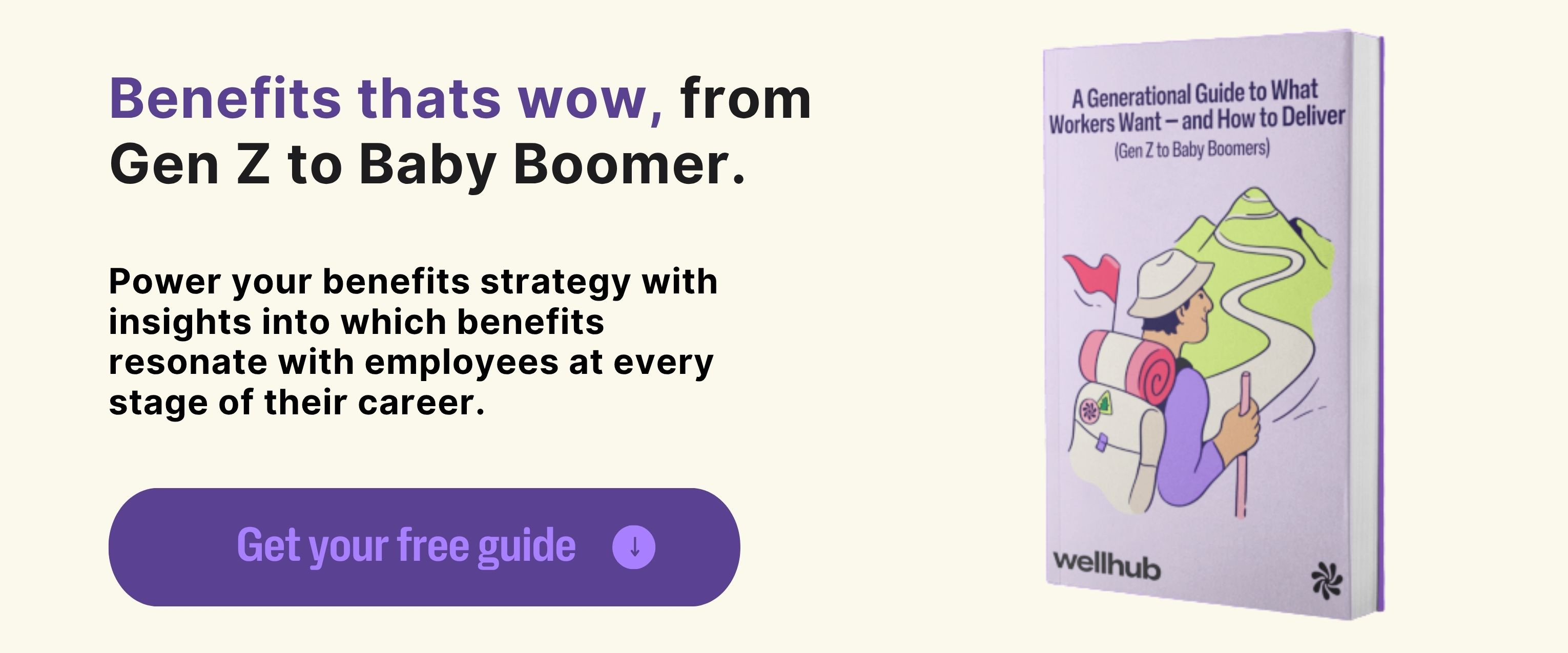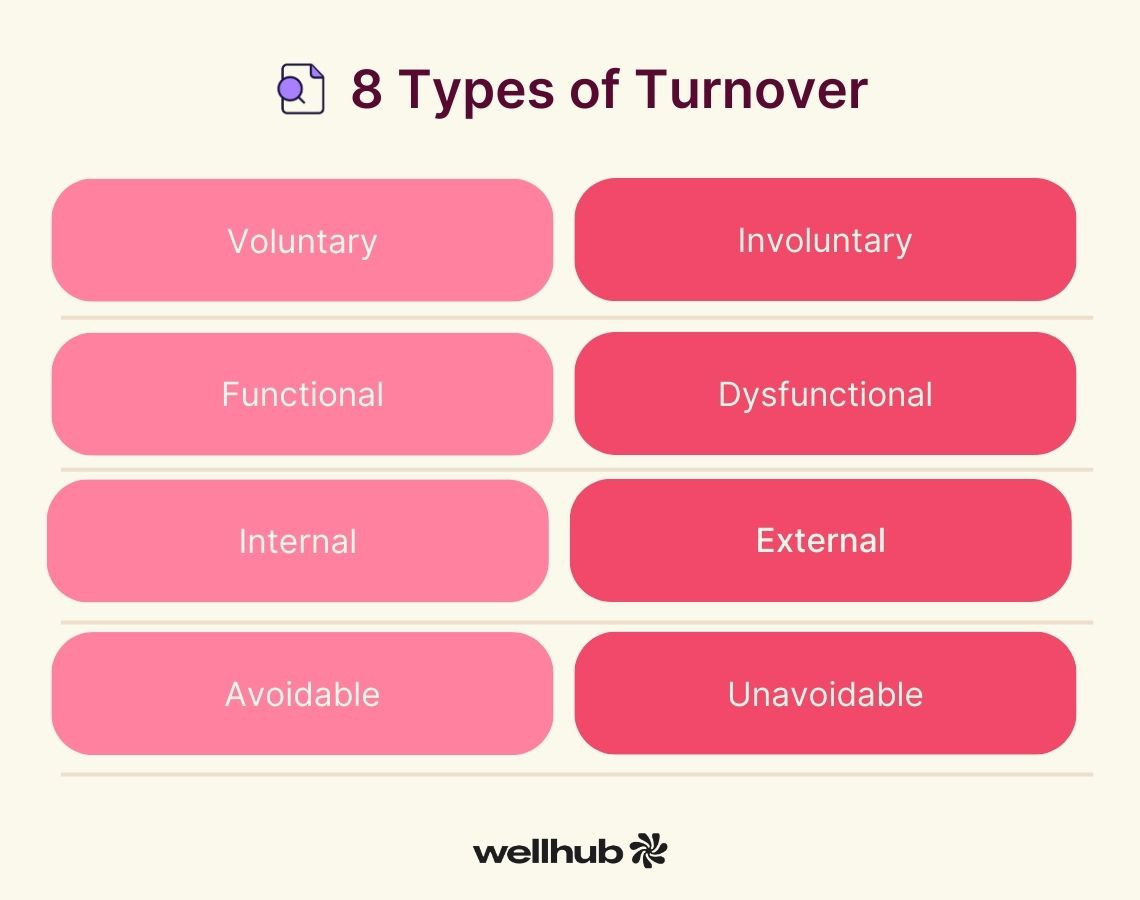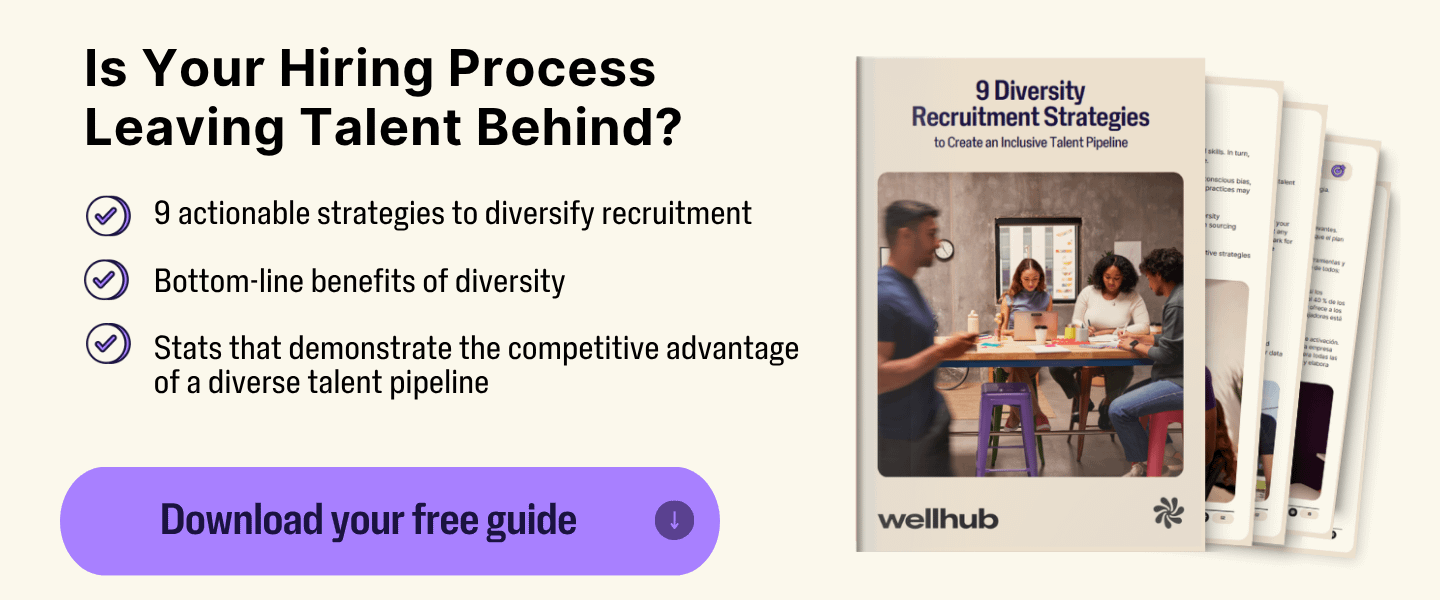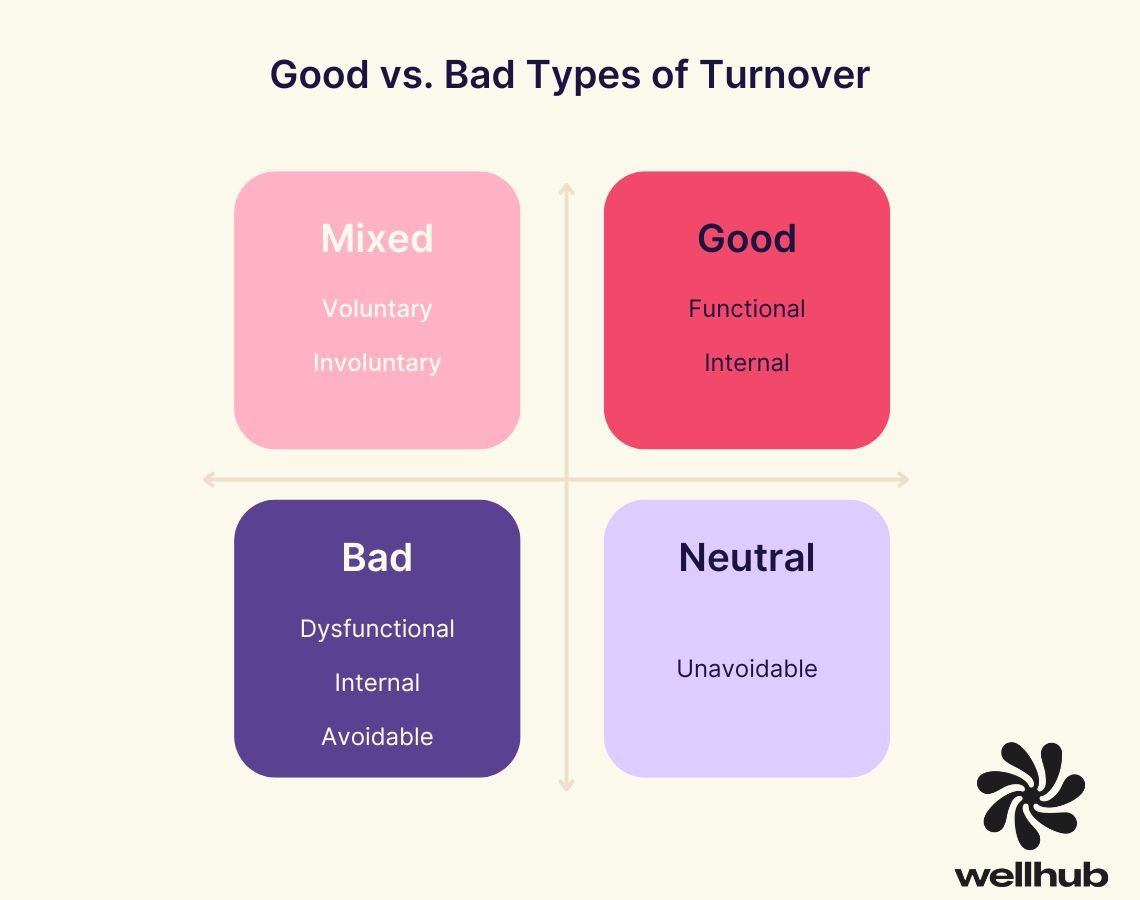8 Types of Employee Turnover To Track: What They Mean and How to Manage Each Kind
Last Updated Sep 24, 2025

When Mary, a seasoned HR leader at a fast-scaling tech company, noticed their turnover rate jump by 15%, she sprang into action. She ran the numbers, presented the data to leadership — and got approval for a flashy new retention initiative.
Six months later? The numbers barely budged. Why? Because she tracked how many people left, but not who or why. The real story was buried in the details: high performers leaving one department, while underperformers in another stayed too long.
Most HR pros have been there. You see the metrics. You make your move. But without understanding the different types of turnover, even the best plans can miss the mark.
This guide breaks down the categories of turnover that matter — and shows how to turn vague data into a powerful strategy for smarter retention, stronger culture, and long-term impact.

What You'll Learn
- Why tracking turnover by type (voluntary, involuntary, functional, dysfunctional, internal, external, avoidable, and unavoidable) provides deeper insight than a single turnover rate.
- How different types of turnover affect business outcomes, from revenue impact to employee morale and knowledge retention.
- Practical methods HR can use to track each turnover category through HR systems, surveys, and performance data.
- Tailored strategies for reducing harmful turnover (like losing top talent) while encouraging healthy turnover (like moving out low performers or promoting internal mobility).
- Warning signs of problematic turnover — such as declining performance, low morale, or repeated loss of high performers — and how to address them proactively.
Why HR Needs Track the Different Types of Turnover
Not all turnover carries the same weight. Some exits free up space for stronger hires, while others can drain institutional knowledge, damage morale, or even derail business strategy. That’s why simply reporting a total turnover percentage isn’t enough. HR leaders need to dig deeper and track the kind of turnover happening inside their organizations.
When you distinguish between types of turnover, you can:
- Spot underlying trends. A high rate of voluntary departures among high performers tells a very different story than a spike in involuntary exits from one department.
- Connect workforce changes to business outcomes. For example, repeated dysfunctional turnover in revenue-generating roles may show up in your bottom line faster than functional turnover in entry-level jobs.
- Build tailored retention strategies. Knowing whether you’re losing people to avoidable issues (like poor management) versus unavoidable circumstances (like retirement) determines whether you should invest in new leadership training or succession planning.
- Make the business case to the C-suite. Presenting turnover data in categories helps you tie workforce shifts to tangible costs, like lost productivity or recruitment spend, making it easier to advocate for programs that support retention.
In other words: tracking turnover types moves you from a reactive stance (“we lost X% of employees”) to a proactive one (“here’s who we lost, why, and how we’ll prevent unnecessary departures next time”).

Voluntary vs. Involuntary Turnover
Turnover that is voluntary or involuntary depends on who initiates the departure — the worker or the company. Tracking both is essential because it shows whether employees are walking away from your culture or whether business decisions are forcing separations.
Voluntary Turnover
What it is: Voluntary turnover occurs when workers resign, often to pursue a better opportunity, advance their career, or address personal needs. For example, an employee may choose to accept a higher-paying role at a company that offers remote work and a clearer path to a senior leadership position.
What voluntary turnover tells HR leaders: High voluntary turnover — especially among top talent — signals issues that drive people out, such as low morale, burnout, or uncompetitive pay. It gives leaders a pulse check on whether the employee experience matches market expectations.
How to track voluntary turnover:
- Use your HRIS to categorize resignations as voluntary.
- Supplement with exit interviews or surveys to capture why employees left (better pay, wellbeing concerns, career advancement, etc.).
- Segment by department, tenure, and performance level to uncover patterns.
How HR can effectively manage voluntary turnover:
- Conduct regular stay interviews to uncover issues before they drive resignations.
- Benchmark pay and benefits against competitors.
- Offer clear career paths and professional development opportunities.
- Foster a culture of wellbeing to reduce stress and burnout.
Involuntary Turnover
What it is: Involuntary turnover happens when an employer decides to end someone’s job, whether due to an individual's poor performance or bigger company changes, such as budget cuts or reorganization.
What involuntary turnover tells HR leaders: A consistently high rate of involuntary turnover may point to deeper problems in recruitment, onboarding, or performance management. It’s a mirror for how well the organization equips people to succeed once they’re hired.
How to track involuntary turnover:
- Log terminations in your HR system with reasons coded (performance, restructuring, policy violation, etc.).
- Compare involuntary turnover rates across teams or managers — a spike may point to leadership or hiring issues.
- Track time-to-termination (how long after hire employees are exiting involuntarily) to spot onboarding weaknesses.
How HR can effectively manage involuntary turnover:
- Strengthen recruitment practices with structured interviews and skills assessments.
- Set clear performance expectations from day one.
- Provide continuous feedback and coaching rather than waiting for annual reviews.
- Track termination patterns to identify whether specific teams or managers need extra support.

Functional vs. Dysfunctional
Departing employees will have either a functional or dysfunctional impact on the company's performance, culture, and bottom line. Separating the two helps leaders understand whether turnover is clearing obstacles or draining talent.
Functional Turnover
What it is: Functional turnover happens when poor performers or disruptive workers leave, creating space for better-fitting employees. This can be voluntary, like if an employee quits because they can’t meet expectations, or involuntary, such as when a company terminates someone for poor performance.
What functional turnover tells HR leaders: Functional turnover indicates whether performance management practices are working. If low performers are exiting and being replaced with stronger talent, your systems are healthy. If not, you may be tolerating disengagement longer than you should.
How to track functional turnover:
- Define “low performance” using your performance review or KPI system.
- Match exits against this data — if a departing employee had consistently low ratings, categorize as functional.
- Measure the percentage of functional turnover to assess whether performance management practices are working.
How HR can effectively manage functional turnover:
- Ensure low performers receive coaching and chances to improve before exit.
- Use performance reviews to spot misalignment early.
- Celebrate when functional turnover opens space for stronger hires.
- Use data to confirm whether turnover is actually improving team performance.
Dysfunctional Turnover
What it is: Dysfunctional turnover happens when high-performing or hard-to-replace employees leave. Their departure can significantly hurt productivity and morale.
What dysfunctional turnover tells HR leaders: Dysfunctional turnover is a red flag. It reveals gaps in recognition, career growth, or workplace culture that push valuable employees out — problems that can’t be ignored without risking long-term damage.
How to track dysfunctional turnover:
- Flag exits of high performers (top 20% based on reviews, KPIs, or sales numbers).
- Track retention of high-potential employees (often identified in succession planning).
- Pair with engagement survey results to catch early signs of dissatisfaction before top talent walks away.
How HR can effectively manage dysfunctional turnover:
- Recognize and reward top talent frequently and publicly.
- Hold regular career conversations to align goals with growth opportunities.
- Monitor engagement survey results for signs of dissatisfaction among high performers.
- Create succession plans so critical roles don’t leave the business vulnerable.
Internal vs. External Turnover
Knowing the difference between internal and external turnover can help HR leaders understand retention trends and career paths within the organization.
Internal Turnover
What it is: Internal turnover occurs when an employee changes positions within the same organization due to a promotion or a transfer to another department.
What internal turnover tells HR leaders: High internal turnover signals healthy career mobility. It means your workforce sees long-term opportunities with you — a powerful retention driver.
How to track internal turnover:
- Record internal moves in your HRIS (promotions, lateral transfers).
- Track how often employees move internally versus leaving the company altogether.
- Cross-check with employee survey data: do people feel there’s a clear path for advancement?
How HR can effectively manage internal turnover:
- Build formal internal mobility programs with mentorship and training.
- Make promotion and transfer processes transparent and fair.
- Recognize and celebrate internal moves to reinforce a growth culture.
- Track career path data to ensure opportunities are spread equitably across departments.
External Turnover
What it is: External turnover is when a worker leaves to take a position at a different company.
What external turnover tells HR leaders: External turnover spotlights your competitive positioning in the market. If people leave for better pay, flexibility, or benefits, that’s data to bring to leadership when advocating for improvements.
How to track external turnover:
- Count all exits to outside organizations.
- Collect reason-for-leaving data via exit interviews or anonymous surveys (e.g., pay, lack of flexibility, limited growth).
- Compare against market benchmarks for compensation and benefits to see if you’re falling behind.
How HR can effectively manage external turnover:
- Conduct exit interviews to understand why people leave for other employers.
- Use anonymous surveys to gather insights from current staff about pay, benefits, and culture.
- Strengthen employer branding to make staying attractive.
- Regularly update compensation and flexibility policies to stay competitive.
Avoidable vs. Unavoidable Turnover
Could your company have prevented the loss of some of its employees? This is the difference between avoidable and unavoidable turnover.
Avoidable Turnover
What it is: Employees may leave an organization for reasons an employer could have prevented, such as:
- Poor management
- Lack of growth opportunities
- Below-average compensation
- Hostile work environments
What avoidable turnover tells HR leaders: Avoidable turnover is the clearest signal of what needs fixing. If patterns show people leaving for preventable reasons, it validates investments in management training, pay equity, or culture improvements.
How to track avoidable turnover:
- Tag reasons for leaving that stem from organizational issues (management style, pay dissatisfaction, lack of growth).
- Survey stayers as well as leavers to validate whether these issues are systemic.
- Monitor trends quarterly — avoidable turnover should decline if interventions are working.
How HR can effectively manage avoidable turnover:
- Address management training and leadership development.
- Review and adjust compensation packages regularly.
- Offer meaningful growth opportunities and learning programs.
- Build a culture of wellbeing to address stress, burnout, and disengagement.
Unavoidable Turnover
What it is: Unavoidable turnover happens because of factors beyond an employer's control — when an employee retires, relocates because of a partner’s job move, or leaves due to serious illness, for example.
What unavoidable turnover tells HR leaders: Unavoidable turnover highlights the importance of succession planning and knowledge transfer. You can’t stop these exits, but you can prepare for them to reduce disruption.
How to track unavoidable turnover:
- Record exits due to retirement, relocation, health, or family obligations separately from avoidable causes.
- Analyze by age group and tenure to forecast upcoming retirements or predictable transitions.
- Build succession plans around roles where unavoidable turnover is expected.
How HR can effectively manage unavoidable turnover:
- Prepare succession plans for critical roles well in advance.
- Build cross-training programs to spread institutional knowledge.
- Support employees with flexible arrangements during life transitions.
- Recognize and celebrate departing employees to maintain morale.
Good vs. Bad Turnover: Knowing the Difference
Not every employee departure is a disaster — and not every one is a win. Some turnover clears the way for stronger hires and fresh energy, while other turnover drains your organization of high performers and hard-to-replace expertise. The key is knowing the difference.
When you sort turnover into “good” and “bad,” you give yourself a clearer lens to evaluate what’s really happening in your workforce. Are you losing the people you most want to keep? Or are you successfully moving out those who weren’t aligned with your culture and goals?
Here’s a quick reference guide:
- Good Turnover: Functional turnover (when underperformers leave) and internal turnover (when employees grow into new roles within the company).
- Bad Turnover: Dysfunctional turnover (when top talent leaves), external turnover (when employees head to other organizations), and avoidable turnover (when preventable issues push people out).
- Mixed Turnover: Voluntary and involuntary turnover, which can be either healthy or harmful depending on who’s leaving and why.
- Neutral Turnover: Unavoidable turnover, such as retirement or relocation, which is expected but requires planning.
Understanding which bucket an exit falls into helps you focus your energy where it matters most — reducing bad turnover while creating space for healthy, functional movement inside your organization.

How to Increase Good Turnover and Decrease Bad Turnover
Once you know the type of turnover you’re dealing with, the next step is shaping it. Some turnover is healthy — even necessary — for keeping your workforce strong. Other turnover is damaging and costly. The goal is to increase the kinds of exits that benefit your organization and reduce the ones that hurt it. Here’s how to approach each category:
Voluntary Turnover
- How to increase good voluntary turnover:
- Support positive exits when employees aren’t a good fit.
- Encourage career transitions when roles misalign with skills.
- Maintain alumni networks to keep doors open for boomerang hires.
- Support positive exits when employees aren’t a good fit.
- How to decrease bad voluntary turnover:
- Conduct stay interviews to catch dissatisfaction early.
- Benchmark compensation and benefits against competitors.
- Provide clear career growth and learning opportunities.
- Prioritize employee wellbeing to lower stress and burnout.
- Conduct stay interviews to catch dissatisfaction early.
Involuntary Turnover
- How to increase good involuntary turnover:
- Use performance data to identify persistent underperformance.
- Act decisively on disruptive behavior that harms culture.
- Ensure termination decisions are fair, data-driven, and transparent.
- Use performance data to identify persistent underperformance.
- How to decrease bad involuntary turnover:
- Improve hiring practices with structured interviews and skill assessments.
- Set clear expectations during onboarding.
- Provide consistent coaching and feedback to give employees every chance to succeed.
- Improve hiring practices with structured interviews and skill assessments.

Functional Turnover
- How to increase good functional turnover:
- Strengthen performance management processes to identify disengagement early.
- Create performance improvement plans with clear goals and timelines.
- Treat turnover as an opportunity to upgrade team skills.
- Strengthen performance management processes to identify disengagement early.
- How to decrease bad functional turnover:
- Verify that exits labeled “low-performing” aren’t caused by poor management or lack of resources.
- Use exit interview data to ensure the root cause is performance-related.
- Verify that exits labeled “low-performing” aren’t caused by poor management or lack of resources.
Dysfunctional Turnover
- How to increase good dysfunctional turnover:
- Rarely applicable — but when it happens, gather insights to prevent similar losses in the future.
- How to decrease bad dysfunctional turnover:
- Recognize and reward high performers consistently.
- Hold regular career conversations to align roles with aspirations.
- Adjust pay and benefits to remain competitive in your market.
- Invest in wellbeing programs to prevent burnout and disengagement.
- Recognize and reward high performers consistently.
Internal Turnover
- How to increase good internal turnover:
- Build structured career mobility programs with mentorship and training.
- Celebrate promotions and transfers to reinforce a growth culture.
- Track career paths to ensure equitable access to advancement.
- Build structured career mobility programs with mentorship and training.
- How to decrease bad internal turnover:
- Ensure promotions are based on readiness, not just tenure.
- Prevent lateral transfers that don’t match long-term career goals.
- Ensure promotions are based on readiness, not just tenure.
External Turnover
- How to increase good external turnover:
- Smoothly transition out employees who are mismatched for their roles.
- Maintain strong relationships with alumni who can become advocates or rehires.
- Smoothly transition out employees who are mismatched for their roles.
- How to decrease bad external turnover:
- Conduct regular compensation benchmarking.
- Use pulse surveys to spot disengagement before it escalates.
- Enhance employer branding to highlight culture, benefits, and wellbeing.
- Conduct regular compensation benchmarking.
Avoidable Turnover
- How to increase good avoidable turnover:
- Not applicable — avoidable turnover should always be minimized.
- How to decrease bad avoidable turnover:
- Invest in manager training to address poor leadership practices.
- Reassess workloads to prevent burnout.
- Offer career advancement and skill development opportunities.
- Provide robust wellbeing programs to meet employee needs.
- Invest in manager training to address poor leadership practices.
Unavoidable Turnover
- How to increase good unavoidable turnover:
- Celebrate life milestones such as retirement to maintain positive culture.
- Anticipate upcoming transitions with succession plans and leadership pipelines.
- Celebrate life milestones such as retirement to maintain positive culture.
- How to decrease bad unavoidable turnover:
- Capture critical knowledge before retirements or relocations.
- Offer flexible arrangements when possible to delay exits.
- Capture critical knowledge before retirements or relocations.
Signs of Problematic Turnover
Not every type of employee turnover is harmful. Some exits are natural and even healthy for an organization. But be aware of the following red flags:
- Declining performance. When employees leave, their responsibilities often get redistributed. That can stretch remaining staff too thin, leading to burnout and drops in productivity.
- Low morale and disengagement. Frequent departures can create a sense of instability and job insecurity, dragging down overall employee satisfaction.
- Rising absenteeism. High turnover often leads to stress and disengagement, which can show up as more sick days and lower-quality work.
- Frequent loss of high performers. When top talent walks out the door, the cost is more than financial — it’s the disruption of expertise, momentum, and leadership.
- Patterns in exit feedback. If exit interviews consistently surface themes like poor management, lack of growth, or burnout, those patterns signal deeper organizational issues.
Noticing these signs early can help drive success in your HR department. To reduce problematic turnover, start by addressing the root causes. Check exit interview trends and get consistent feedback from your employees regarding issues such as poor management, limited growth opportunities, and inadequate pay.
Retention Strategies by Employee Type
To improve retention start by understanding why different groups of employees leave, then tailor your strategies to their specific needs. This targeted approach can make a real difference in reducing workforce turnover.
High Performers vs. Underperformers
The best way to maintain productivity is by keeping your high-performing employees happy and engaged. It's also worth providing resources for underperformers to help them improve and prevent burnout.
Tips for retaining high-performers
High performers stay when they believe their work makes a difference and their leaders recognize potential beyond their current role, according to Forbes. Here are a few tips for retaining your best talent:
- Publicly recognize their efforts and achievements
- Offer competitive compensation and benefits
- Encourage open communication about career goals and growth opportunities
- Provide manageable challenges that stretch their skills
Tips for retaining underperformers
Underperforming employees often make up to 20% of an organization’s workforce, according to Culture Amp’s research. You can help them improve by:
- Offering training, coaching, and mentorship
- Providing instructive, actionable feedback frequently (a few times per week, ideally)
- Recognizing progress and small wins
- Creating a burnout battle plan
New Hires vs. Long-Term Employees
Addressing retention among newer employees vs. long-standing ones requires slightly different strategies.
New hire retention tips
Effective onboarding can help reduce new-hire turnover. Here are some actionable best practices you can implement:
- Assign onboarding buddies to give new employees a go-to person for questions and support.
- Provide sufficient training and necessary tools to help new hires perform their jobs effectively.
- Set clear 30-, 60-, and 90-day goals. Schedule regular check-ins to keep expectations aligned.
Tips for retaining long-term employees
To keep long-term employees in your company, you can:
- Recognize and reward loyalty, such as years of service awards
- Provide wellness benefits, such as gym memberships
- Maintain competitive pay and benefits
- Offer professional development courses, certifications, and other career-advancing opportunities
Remote, Hybrid, and In-Person Roles
Here’s how to customize your retention efforts based on where employees work:
| Work Setup | Key Retention Strategies |
Remote |
|
Hybrid |
|
In-person |
|
Improving Employee Retention Starts With Wellbeing
Understanding different types of employee turnover can help you determine why employees are leaving and give you insights for implementing effective retention strategies.
Supporting employee wellbeing is one of the best retention strategies, especially when you consider that 85% of workers say that their wellbeing at work is as important as their salary.
Talk to a wellbeing specialist to see how you can set up wellbeing programs that support overall employee wellness and boost retention.

Company healthcare costs drop by up to 35% with Wellhub*
See how we can help you reduce your healthcare spending.
[*] Based on proprietary research comparing healthcare costs of active Wellhub users to non-users.
Category
Share

The Wellhub Editorial Team empowers HR leaders to support worker wellbeing. Our original research, trend analyses, and helpful how-tos provide the tools they need to improve workforce wellness in today's fast-shifting professional landscape.
Subscribe
Our weekly newsletter is your source of education and inspiration to help you create a corporate wellness program that actually matters.
Subscribe
Our weekly newsletter is your source of education and inspiration to help you create a corporate wellness program that actually matters.
You May Also Like

Talent Management: Definition, Benefits, and Strategies | Wellhub
Discover talent management best practices to attract, retain, and develop top talent. Leverage these benefits and strategie to align with your business goals.

Employment At Will: What It Means for Employers | Wellhub
At-will employment offers termination flexibility for employers and employees. Explore strategies to mitigate risks and ensure fair practices in the workplace.

6 Essential Team Lead Responsibilities | Wellhub
Team leads take on many responsibilities to help their team be successful. Discover which responsibilities are the most critical for success.